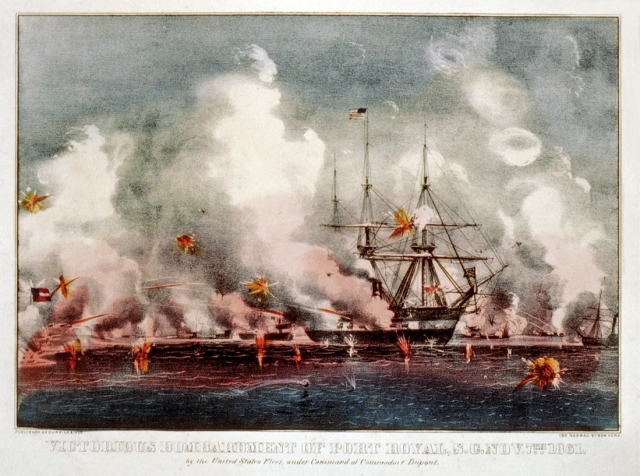
Today marks the 150th anniversary of the Battle of Port Royal—one of the earliest amphibious operations of the American Civil War. The United States Navy fleet and the United States Army expeditionary force worked together captured Port Royal Sound, South Carolina, including Fort Walker on Hilton Head Island and Fort Beauregard on Phillip’s Island. The following is Union Flag Officer Samuel Du Pont’s letter to Secretary of War Gideon Welles, providing a detailed account of the battle.
Sir: — I have the honor now to submit the following detailed account of the action of the 7th of November.
From the reconnoissance of the 5th, we were led to believe that the forts on Bay Point and Hilton Head were armed with more than twenty guns each, of the heaviest calibre and longest range, and were well constructed and well manned; but that the one on Hilton Head was the strongest. The distance between them is two and two-tenths nautical miles, — too great to admit of their being advantageously engaged at the same time, except at long shot. I resolved, therefore, to undertake the reduction of Hilton Head (or as I shall hereafter call it, Fort Walker), first; and afterwards to turn my attention to Fort Beauregard, the fort on Bay Point. The greater part of the guns of Fort Walker were presented upon two water fronts; and the flanks were but slightly guarded, especially on the north, on which side the approach of an enemy had not been looked for.
A fleet of the enemy, consisting of seven steamers, armed, but to what extent I was not informed further than that they carried rifled guns, occupied the northern portion of the harbor, and stretched along from the mouth of Beaufort river to Skull creek.
It was high water on the 7th instant at 11.35 a. m., by the tables of the Coast Survey.
These circumstances, the superiority of Fort Walker, and its weakness on the northern flank, the presence of the rebel fleet, and the flood tide of the morning decided the plan of attack, and the order of battle.
The order of battle comprised a main squadron ranged in a line ahead, and a flanking squadron, which was to be thrown off on the northern section of the harbor to engage the enemy’s flotilla, and prevent their raking the rear ships of the line when it turned to the southward, or cutting off a disabled vessel…
I have said, in the beginning of this report, that the plan of attack designed making the reduction of Fort Walker the business of the day. In passing to the northward, however, we had improved every opportunity of firing at long range upon Fort Beauregard. As soon as the fate of Fort Walker was decided, I dispatched a small squadron to Fort Beauregard, to reconnoitre and ascertain its condition, and to prevent the rebel steamers returning to carry away either persons or property.
Near sunset it was discovered that the flag upon this fort was hauled down, and that the fort was apparently abandoned.
At sunrise, the next day, the American ensign was hoisted on the flag-staff of Fort Beauregard, by Lieutenant Commanding Ammen…
After congratulating you upon the success, thus far, of an expedition which had its origin in the counsels of the Department, and which the Department has fostered and labored to render efficient, the gratifying duty remains to be performed of according to each and all their due share of praise for good conduct in this encounter with the enemy. This duty, though most welcome, is still delicate…
I have the honor to be, respectfully, your most obedient servant,
S. F. Du Pont,
Flag Officer, etc.
Source: DuPont, Samuel Francis. “Letter from Samuel Francis DuPont to Gideon Welles, November 11, 1861,” in Official Dispatches and Letters of Rear Admiral Du Pont, U. S. Navy (Wilmington: Press of Ferris Bros. Printers, 1883).
Image Credit: Library of Congress.
